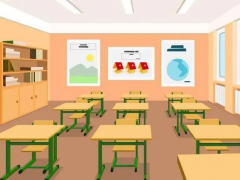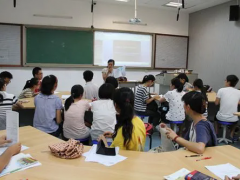小学说课稿范文英文版
小学英语全英文说课稿
Good morning, everyone! Today, Ill say something about Unit 9 Part A in Book 4 of Oxford English. Background on the reformation of curriculum, this book can connect the life and act, emphasize the interest and experience of the Ss, the pictures are active and vivid. Grade four is the initial stage of English learning, so it stresses on the emotion of the Ss, creates a well beginning for the Ss. This Unit has 7 parts, well learn Part A mainly, it embodies the repeating characterize. Review the learned language points “Wheres…”and the new language points will be represented in the following units. So this unit forms connecting links with a special meaning in this book. The content of this period is to use “Wheresare…” to determine the place. And according to the contents and the fact of the Ss, I establish the following three teaching aims of this period: The first one: students can listen, read, say and spell the following words: a glass, a fridge, an egg, bread and a table. The second one: students can listen, read, say and write the following daily expressions: Whats for breakfast? Have some juice then. The third one: students can listen, read, say and write the following sentence patterns: WheresWhere are themy… Its Theyre… Theres no …in on near… I think the most difficult point of this period is to make sure the students can use the patterns “WheresWhere are…and There is no …inonnear…” in their daily life correctly. And I will use some pictures, words and sentence cards, a tape recorder and the multi-media computer to help me achieve the aims. The task-based method, communicated method, group cooperate method will be used in this period. To accomplish the aims, I design the following steps: Step 1 Songs and the game arousers the emotion. In order to attract the Ss attention and construct an atmosphere of learning English, I let the students sing some English songs and play the game “Simon says”. At the same time the game can review the prep, serve the knowledge as foil and consist the appearance of the knowledge. Step 2 Change class to life, happy to say. The substance of language is communication and the environment of communication is life. So when I present the sentence pattern “Whats for breakfast?” I first show a clock to elicit the time for breakfast, teach the sentence. Then show my own photo of having breakfast, Ss ask and guess. In this way I can attract Ss attention, encourage Ss to ask Qs with the new knowledge. Most of the Ss have learnt the sentence pattern: Wheres…? so I design a task for Ss to help Helen find the food and drinks for breakfast, and teach the new language points: Where are…? Theyre … Meanwhile stick the sentences on the Bb. After some practice by asking and answering, I present the next language points: Theres no …inonnear… Have …then. And I will stick these sentence patterns on the Bb. Finally Ill let the Ss do pair works to consolidate them. Step 3 Listen to the tape and Ss imitate to read and say. As the new reformation of curriculum, emphasized the traditional class attach importance to the mechanical teaching, neglect the experience and participation, for example, the five-step method. So in this lesson, after presentation, I ask Ss to listen to the tape with three Qs, read in different roles and in pairs, then try to recite the text. Step 4 Ss be the main body, T makes a guider. In class, Ss play as a host, and the T makes an influence on guiding, help Ss to act the learnt dialogue, it can stress the position of the Ss, and arouse their interest. Then I show a carton with no voice, ask Ss to make a dialogue in pairs. There are lots of ways to consolidate the new knowledge. Playing game is a good way. So according to the physiology of Ss, I hold a group competition during the game, ask Ss to finish the blanks. In this way can develop Ss good habits and achieve the aim of mastering the learned knowledge in situation. Step 5 Change class to life, learn by themselves. Is this the end of the class? I dont think so. If there is an end, I think it should be in the life. So I extend this class, encourage Ss to use the learned to communicate with each other in their life. In a word, the whole period is based on tasks, which are designed from easy steps to steps that are challenging. When the Ss are carting out the tasks, they can acquire information, knowledge, and have their ability and skills trained. Thats all. Thanks a lot for your attention.。
小学英语说课稿-搜狗问问
呵呵你可以把年级什么的改一下,希望能帮到你 Good afternoon , Ladies and Gentlemen ! My name is Wu Dan . I come from Yu Hong Primary School .I am very glad to be standing here and talking about Lesson 10 ,which is from Fun with English Book 3 Unit 2 . My teaching report includes four parts . Part 1 To analyze the book 1.There are 3 units in Book 3 . This is Lesson 10 . The central item is how to master another sentence to express “ Whats the time ? ” and how to buy something. Using “ Whats the time ? ” hungry , cakes, bread and so on . Well study and drill the sentences and the word s pronunciation . 2. According to the teaching outline and combining the students situation , I make the teaching aims of this lesson as follows . a .The first is the aim of knowledge . Its to learn and master two sentences. What time is it? I am hungry and then using them to express the time and go shopping fluently and freely b. The second is the aim of abilities The creative spirit is quite important to the students. So I will pay much attention to train it in my class. Otherwise. I will try to train the students listening, speaking, reading and writing abilities, Mainly improve their communicative abilities and encourage them to speak more English. C. The third is the aim of emotion Make the students have successful feeling and achievement. And make them be in English study. 3.important points The first is to master and use the two sentences. What time is it? Im hungry. The second is to master the usage of the words hungry, cakes and bread. 4.Difficult points. Its the pronunciation of the two words. hungry, cakes, and how to use them fluently and freely . Part 2 . Teaching and learning methods Make the students take part in class . Ask and answer in pairs and groups . Ill use communicative method , discussing method and seeing and hearing method to teach this lesson . Part 3 . Teaching aids . In order to interest the students . Ill use a clock , recorder , cards and some food as my teaching aids . Part 4 . Teaching procedure . Step 1 Revision Before my class , Ill get the students to sing an English song to keep themselves relax . Then Ill use a clock to act it . Whats the time ? Whats the time ? Its eight oclock . Ill show three numbers . When the students answer Its ten oclock . Ill say : Its ten . Today well learn Lesson Ten . Then Ill put the clock on the blackboard . Step 2 Presentation and drill First Ill point to the clock and ask , what time is it ? Students answer Its ten . Then I go on moving the hands and ask .What time is it ?Students answer quickly . Second Ill drill the sentences What time is it ? Its ----- .pairs in pairs or row by row . Third When the students answer Its 12:00 oclock . Ill point to my stomach and say .Oh Im hungry .and Ill eat a cake . Then Ill go on saying Im hungry .and Ill eat another cake . Ill act it four or five times . Then I ask a student to act it . Im hungry , too . Ill say two cakes , please .and the sentences .Im hungry . Two cakes ,please. Forth :Listen to the dialogue and answer my questions. 1.What time is it? 2.How many cakes? Step 3 Consolidation Ill train the creative spirit of the students. Ill give them three please. To act the dialogue freely .First at the 219 Park,second fruit shop Third department store. Step4.Homework Encourage my student to the market to buy something with his friends or parent Background of English teaching in primary school: It is not a long history that English is as a subject in primary school in our country and the main instructional aims of teaching English in primary school is to cultivate pupils basic abilities of their listening and speaking and their good sense of the English language. Our boys and girls are exposed to English for the first time, so it is very important to develop their keen interest in English. I. Contents: Today Im going to talk about Part B of Unit 2, PEP Primary English, Book 3. This lesson includes two parts: Lets talk and lets practice. In section 1, it mainly deals with the dialogue about “Whats in the schoolbag?” and the answers. And in section 2, it provides a real situation for the Ss to prastise the pattern: How many +n.(pl.)+ do you have? And the answer: I have 23 +n.(pl.) II. Teaching aims 1. Aims on the knowledge (1) To enable the Ss to understand and speak: “My schoo lbag is heavy. Whats in it? Thank you sooooooo much.” Make sure that Ss can use these sentences in real situations. (2) To help Ss to finish the survey. (3) Let Ss finish the assessment of “Lets check” in this unit. 2. Aims on the abilities (1) To develop Ss 。
求小学英语纯英文的"说课稿"我们被要求说5分钟的春英语的英语说
一、说教材 1.教材简析。
本课共有两部分内容,其中第一部分是以中秋节为话题而展开的一个对话。它主要讲了Han Mei和Lucy简单谈论有关中秋节和月饼方面的知识,并邀请Lucy到她家作客的过程。
在这个对话中出现了如autumn和festival等十一个新单词以及几个学生难以理解的、需教师解释的词、句型和句子。 第二部分内容是两人在商店为朋友买月饼的一个情境,谈话内容是从月饼表面的样子的好坏、大小、轻重和价钱等方面展开的。
其中出现了形容词比较级的用法,它们是:nicer, bigger, heavier, cheaper。它要求学生根据图、词和句子提示创造性的对话。
2.教学重点。 (1)指导学生掌握和熟练运用那些难以理解的词、句型和句子,如cakes with meet。
(2)指导学生口头熟练表达就中秋节这一话题展开的对话内容,包括第二部分的购物经过。 (3)形容词比较级的用法。
3.教学难点。 学生根据实际情境需要真正开口讲英语。
4.教学目标。 (1)技能目标。
学生能听懂本对话录音,能听懂师生之间就本对话内容而展开的、切形式的问答,会和别人展开对话,了解和传递信息;能就本课语言难点造句,而且无语法错误;能就类似话题,创造性地自编对话;掌握形容词比较级的用法。 (2)知识目标。
学生要牢记所有新学单词,包括重点字母或字母组合的发音,还要记住新学短语、句型、难句及本对话各句的英语表达,为实现自如讲英语奠定基础。 (3)情感目标。
学生要爱学英语、爱说英语、想说英语,对英语学习投以极大的兴趣和热情。 (4)学习策略目标。
改变传统的死记硬背,积极主动地投入到语言的实践中去,包括听、说、读、写的实践。在实践中提高语言的综合使用能力,加深对基础知识的掌握和记忆。
(5)文化意识目标。使学生进一步了解和会简单向别人介绍中国这个传统节日,从而体会节日的快乐。
二、说教法 对本课我主要采取了如下几种教法: 1.听录音。 听音是英语学习的重要方法,也是课堂教学的重要步骤。
在听中可以感知,可以模仿。 2.重点解释,个别操练。
在每一堂教学中,学生总会遇到一些难以理解的词、句型、短语、句子或某一语法现象。 如本课出现的形容词比较级的用法等都需要教师个别解释甚至创设语言情境进行操练和举例,以扫除自由交际过程中的“拦路虎”,为语言的进一步学习奠定基础。
3.指导学生展开情景对话。 教师可以和任何一个学生对话。
开始时和学习好的可多说几句,和学习差的可以少说几句,要想办法使人人开口,使人人都有成功感。 通过对话逐步达到对教材内容的全部操练。
在对话时可不受课文内容和顺序的限制,师生完全可以根据当时的实际思路创造性地交流,这种教法是实现语言知识向语言能力转变的必经之路。师生对话时,其他学生静听。
4.学生独立操作。 首先要求学生根据师生示范独立对话,随后叫几组分别站起来表演。
这是深化课堂教学的重要举措。 5.教师可设计填空或翻译练习,以检查学生对本对话的掌握情况。
在整个教学活动中,我还采用了投影仪、挂图、卡片、实物等,对顺利开展教学活动起到了很好的辅助作用。 三、说学法 我所采用的教法有助于学生掌握如下学法: 1.养成听的习惯。
学生要经常听录音,听教师讲英语,听同学们讲英语,这对学好英语大有好处。 2.科学储备大量知识。
学生不掌握丰富的知识就不可能进行很好的语言交流。所以学生必须了解语言规律,掌握丰富的词汇,熟知语法规则,会熟练表达由各个话题而展开的交际内容。
要学会在实践中学,在应用中学,这样学来的知识记忆深刻、灵活度大。 3.及时巩固,反复记忆。
凡教师在课堂上所讲到的语言难点,学生应及时整理,再次认识并积极使用。对前面已学过的课文,学生要有安排地经常复习,否则常常是学了新的,忘了旧的。
4.积极操练,重在口头。 在课堂上,学生要积极参与教师设计的每个教学活动,要大胆开口,创造性地说自己想说的话。
课后和其他同学及时进行英语交流。只有这样,才能将书本知识变成自己的知识和语言能力;也只有这样,才能实现脱口说英语的目的。
四、说教学程序 1.复旧引新阶段。 教师和学生进行简单的问候,如: Ss: Good morning, teacher! T: Good morning, class! 之后,就上单元的话题和学生展开对话: T: Comrades! We wont have any lessons this afternoon。
Im going on a field trip。 Would you like to go with me? Ss: Yes, we do。
T: Where are we going? Ss: Were going to the mountains /rivers / hills。 。
。 T: What do you think were going to do? Ss: Were going to have a picnic /discuss the air outside。
教师可根据当时的情况和学生继续多谈几句,交谈的思维要顺着学生的思维展开。 之后,老师问道: T: Do you know what day is tomorrow? Ss: Yes, we do。
/No,we dont。 T: Now let me tell you。
Tomorrow is Mid-autumn Festival。 Were going to have a big dinner。
Would you like to come to my home to eat something? Ss: Yes, wed love to。 到此引出新学课文,教师说:Now lets learn Lesson9。
之后板书“Lesson9”。 2.熟悉语言阶段。
(1) 学生看着书听一遍。
急求人教版小学英语说课稿
说课的内容包括:说教材,说教法、说学法、说教学过程。
1、说教材 教者要说明自己对教材的理解,因为对教材理解透彻,才能制定出较完满的教学方案。 说教材包括三个方面内容: (1)教材简析。
在认真阅读教材的基础上,说明教材的地位、作用。 (2)明确提出本课时的具体教学目标。
课时目标是课时备课时所规划的课时结束时要实现的教学结果。课时目标越明确、越具体,反映教者的备课认识越充分,教法的设计安排越合理。
说课中要避免千篇一律的套话,要从识记、理解、掌握、应用四个层次上分析教学目标。分析教学目标要从知识与技能、过程与方法和情感态度价值观三个方面加以说明。
(3)分析教材的编写思路、结构特点确定教学重难点和关键。 2、说教法、学法 不同学科的教学方法和学习方法存在很大的差异,每一种方法都有其特点和适用范围,不存在任何情况下对任何年龄学生都有效的教学方法。
因此,说课者要从实际出发,选择恰当的教学方法和学习方法。而且,随着教学改革的不断深入,还要创造性地运用新的教学方法。
一般来说,任何一节课都是多种教学方法的综合运用,说课者要注意说明这节课的教学内容应以哪种教学方法为主,采用哪些教学手段。无论以哪种教法为主,都是结合学校的设备条件以及教师本人的特长而定的。
要注意实效,不要生搬硬套某一种教学方法,要 注意多种方法的有机结合,提倡教学方法的百花齐放 英语:直接教学法 听说法 交际法 任务教学法 语法翻译法 全身反映法 从学法指导来看,现代教育对受教育者的要求,不仅是学到了什么,更主要的是学会怎样学习。说课活动中虽然没有学生,看不到师生之间和学生之间的多边活动,但教师必须说明如何根据教学内容、围绕教学目标指导学生学习,教给学生什么样的学习方法,培养学生哪些能力,如何调动学生积极思维,怎样激发学困生学习兴趣等。
从教师的说课过程中要体现以学生为主体,充分发挥学生在学习活动中的作用 英语:小组合作法 看、听、说、读、写 演、唱、画、玩、做、视听 3 、说教学过程 说教学过程是说课的重点部分,因为通过这一过程的分析才能看到说课者独具匠心的教学安排,它反映着教师的教学思想,教学个性与风格。也只有通过对教学过程设计的阐述,才能看到其教学安排是否合理、科学,是否具有艺术性。
通常,教学过程要说清楚下面几个问题。 1 、教学思路与教学环节安排。
说课者要把自己对教材的理解和处理,针对学生实际,借助哪些教学手段来组织教学的基本教学思想说明白。但具体内容只须概括介绍,不能按教案像给学生上课那样讲。
另外在介绍教学过程时不仅要讲教学内容的安排,还要讲清“为什么这样教”的理论依据(包括大纲依据、课程标准依据、教学法依据、教育学和心理学依据等)。 2 、说明教与学的双边活动安排。
这里说明怎样体现教师的主导作用和学生的主体活动和谐统一,教法与学法和谐统一,知识传授与智能开发的和谐统一,德育与智育的和谐统一。 3 、说明重点与难点的处理。
要说明在教学过程中,怎样突出重点和解决难点,解决难点运用什么方法。 4 、说明采用哪些教学手段辅助教学。
什么时候、什么地方用,这样做的道理是什么? 5、说清练习环节的设置。
求一份完整的英语说课稿
各位老师:大家好! 让学生愉快地、充满自信地走进我的英语课堂,是我最大的愿望,让学生在我的英语课堂上享受快乐和成功是我孜孜以求的。
我为实现自己的梦想和追求不懈地努力着。今天,借此平台,愿与大家一起分享我的说课,让我们一起探讨,共同成长。
我说课的内容是牛津小学英语4A Unit6 Whose gloves?第二课时。一. 说教材 教学内容 本单元的话题是寻找物主,要求学生围绕服饰类的英语单词,在一定的情景下,能正确使用Whoes is this/are they?进行交谈。
在学习完第一课时的基础上,我确定了本课时的教学内容为:A(4-6),B (a pair of shorts,a scarf,a aweater,ajacket),C(Whose…is it/are they?Its/Theyre xxxs). 教材地位 本课时中出现的xxxs,在前面的第三单元中已有所接触,可以说是Unit3的知识延续,具有承上启下的作用。服饰类单词的单复数使用更是对今后的单复数学习有着重要作用。
根据《英语课程标准》的教学理念,教材特点以及四年级学生的实际情况,本课的教学目标确立为: 知识目标 1.能够听、说、读a pair of shorts,a scarf,四会a sweater,a jacket 2.能够听懂、会说、会读、会写本课时的主要句型:Whose…is this/are they?Its/Theyre…并能在适合的情景中自由运用。 3.能够跟录音朗读对话,并能分角色进行表演。
能力目标 1.要求学生能围绕服饰类单词,在一定情景下,正确使用Whose…is it/are they?及回答Its /Theyre xxxs.进行交谈。 情感目标 1. 培养学生良好的学习习惯和形成有效的学习策略。
2. 培养学生对美的鉴赏和认识。 在仔细研究教材和分析学生的心理和生理特点的基础上,我认为本课重点是掌握有关寻找失主的句型:Whose…is this/are they? Its /They are xxxs.等有关服饰的表达法。
难点是A pair of …of… 中of的读音;能正确运用Whose…is this/are they? Its /They are xxxs单复数的提问。 二. 说教法 我将采用情景法、全身反应法、直观法等教学方法,以学生为主体,以Whose…is this/are they?这个话题为核心,以语言功能为主线,以任务型活动为媒介,从学生的学习兴趣、生活经验和认知水平出发,使学生通过感知、体验、实践、参与、合作与交流的方式实现任务目标,使课堂活起来,让学生动起来,从而达成上述的知识与技能目标。
三. 说学法 我采用歌曲和chant 贯穿整堂课中,利用简笔画、实物投影、课件等多种手段,创设在化妆舞会中伙伴们对各人的打扮进行评论的情境,采用多种形式的操练方式,让学生在交流中理解,在交流中掌握,在交流中记忆,让学生在不同的活动中感知语言和习得语言,从而来突出重点和突破难点。 四. 说教学过程 本课我通过导入设计、新课呈现、巩固操练、拓展延伸以及课后作业五个步骤进行设计。
教育家托尔斯泰说过:“成功的教学所必须的不是强制,而是激发学生的兴趣,兴趣是推动学生学习的强大动力,是学生参与教学活动的基础,激发学生的兴趣是新课导入的关键。”“Well begun, half done”良好的开端是成功的一半。
导入设计分三块: ①唱一唱第四单元的歌曲“We are happy bees”(Which is for you,which is for me.This one or that one. )这一首优美的英文歌,全班同学在教师的带领下,边拍手边唱,营造良好的英语氛围,使学生能自然地进入到一个良好的学习状态中。 ②通过实物投影和简笔画,复习一下上节课的单词:Whats this in English?Its a…What are they?They are…答对的学生们可让他们穿上自带的衣物进行一次走秀,让全班学生能够说起来,动起来。
在复习旧知的基础上为新课的学习起到一个呈上起下的作用。 ③Free talking:Look at xxxs… 评论一下学生们的打扮,为后面创设校园coseplay,伙伴们都穿着漂亮的衣服参加服装秀的情境埋下伏笔。
同时也营造一种民主、和谐、宽松的英语氛围,为学生架设一座由中文思维向英文思维过渡的桥梁。 新课呈现分两部分: ①利用课件,出示一个学生熟悉的人物Liu Tao,他也来参加coseplay.点击他身上的衣服,询问学生并引出a pair of shorts。
操练chant: shorts, shorts, a pair of shorts , a pair of shorts for my friend.同法操练其余的三个:a scarf,a sweater,a jacket。通过师生、生生之间的大量语言交流,鼓励学生大胆开口,勇敢表达,逐渐让学生体会到学习英语的快乐 ②创设校园coseplay的情境,教师扮演一位评委,引出句型Look at xxx.Shes funny.Look at her gloves.Theyre so big.等等。
师生练说此类句型。然后通过采访,引出句子Whose …is it?Its xxxs.Whose…are they?Theyre xxxs.师生围绕coseplay,操练Whose …is it?Its xxxs.Whose…are they?Theyre xxxs。
这两个句型,并且区分be动词单复数的使用。苏霍姆林斯基说过:没有也不可能有抽象的学生。
因此,我们要鼓励孩子们大胆地用英语表达,让他们知道“English, I can”. 巩固操练分五部分: ①说一说,利用教学卡片,在黑板上制作衣物小转盘,操练单词等。 ②玩一玩,鲁迅说过:“游戏是儿童的天使。”
本节课我设计“我猜,我猜,我猜猜”的游戏来操练句型 Whose…is it/ are they?Its xxs,I think./ They are 。






